Last week I surrendered to geekdom peer pressure and went to see the new summer blockbuster Pacific Rim. Living up to my namesake, St. Anthony, I normally don't have a problem resisting such temptations, and just wait to see a movie like this in some other format: DVD, Netflix, or the way movies were originally intended to be seen, on a tiny screen on the back of an airplane seat. But what really pushed me to go was the following image, only glimpsed for a few seconds in one of the trailers:
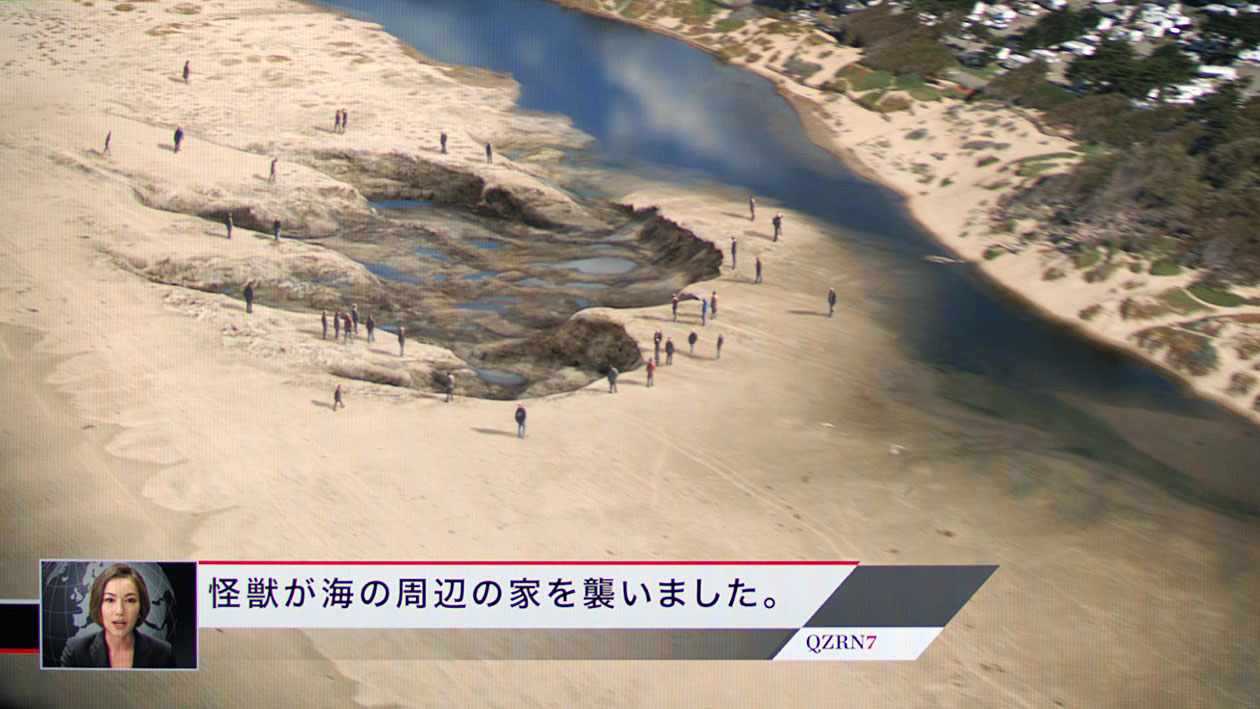 Ooo, look, a trace made in an intertidal sandflat! Perhaps it's from a ghost crab, moon snail, or shorebird. Hey, wait a minute, something doesn't quite look right. Are those people next to it? (Image from http://www.comicbook.com.)
Ooo, look, a trace made in an intertidal sandflat! Perhaps it's from a ghost crab, moon snail, or shorebird. Hey, wait a minute, something doesn't quite look right. Are those people next to it? (Image from http://www.comicbook.com.)
Yes, that’s right: it's a gigantic footprint, and in what looks like an intertidal coastal environment, between the low tide mark and coastal dunes. That was all the incentive I needed, as I further wondered what other ichnological wonders would be included in the film. I was also encouraged to see where other scientifically inclined bloggers had fun with Pacific Rim by taking a look at its biology (here, here, and most recently, here) and physics (here, here, and most recently, here). So given a $5 afternoon matinee and a spouse (Ruth) willing to indulge my sci-fi inner nerd (OK, so it’s not so “inner”), I had every reason to document the various traces and tracemaking activities in the film. You know, for science and science education.
The verdict? Well, I have to admit some mild disappointment with how the director – Guillermo del Toro - chose to focus on the conflicts between massive amphibious creatures (kaiju) constructed by interdimensional aliens and human-guided fighting machines (jaegers), rather than on their traces. Nonetheless, I managed to find some ichnological gems scattered throughout. For example, the footprint shown in the trailer did indeed look glorious on a big screen, and the human figures associated with it reminded me of Jason Isley’s whimsical underwater photos. But let’s take a closer look at what this footprint tells us about its maker.
Although viewed from an oblique angle, the track seems longer than wide, and has four clearly defined digits, although a probable fifth digit is visible on the side farthest from the viewer. All of the digits are forward-pointing and taper abruptly at their ends. The tracks also has an indentation on the “heel” (proximal) part of the foot, and is more-or less-bilaterally symmetrical. Pits inside of the track may represent additional anatomical traits, such as scales or other bumps on its skin, or could be sediment that underwent liquefaction or other soft-sediment deformation.
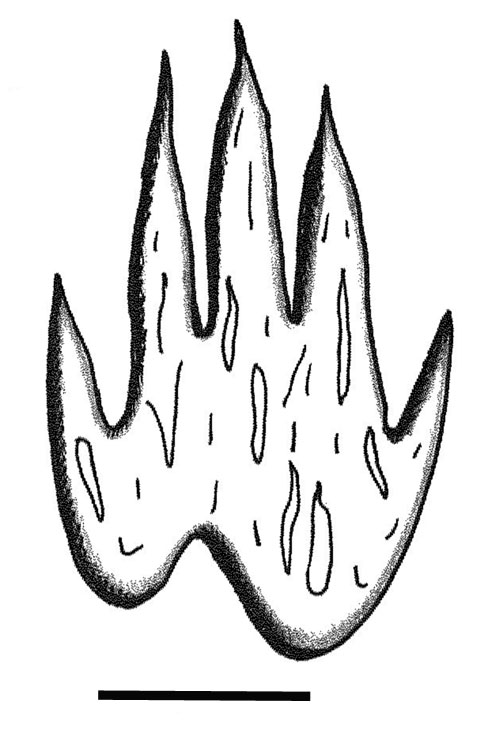 Interpreted kaiju track, extrapolated from oblique view. Scale = 10 m (33 ft).
Interpreted kaiju track, extrapolated from oblique view. Scale = 10 m (33 ft).
Using the people around the tracks as informal units of measurement, and assuming from the hiragana-katakana in the newscast image that this track - like many items - was made in Japan, we can estimate the dimensions of the track. Average heights for Japanese males and females are 1.71 m and 1.58 m, respectively, and the average of those is 1.64 m. Using one figure (boxed) as a unit that equals 1.64 m (5.4 ft), the footprint had about 18.4 Japanese-Person-Units (JPU) length and 10.1 JPU width, which converts to about 30 m (98 ft) long and 17 m (56 ft) wide. This results in a length:width ratio of about 1.8.
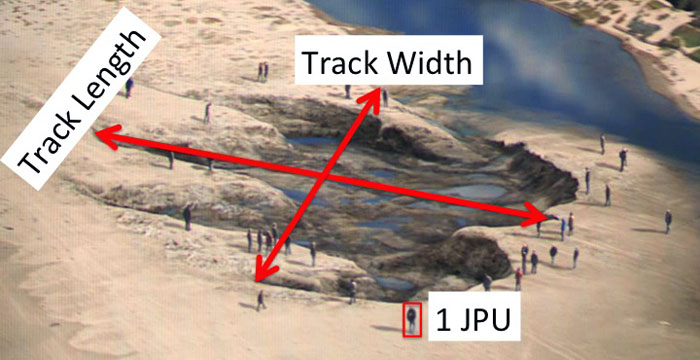 Length and width measurements for kaiju track, including figure used as 1.0 JPU = 1.64 m. Width measurement is assumed on basis of probable fifth digit impression on side of track furthest from the viewer.
Length and width measurements for kaiju track, including figure used as 1.0 JPU = 1.64 m. Width measurement is assumed on basis of probable fifth digit impression on side of track furthest from the viewer.
Unlike in most articles published in high-impact journals, I'll actually admit potential sources of error in these measurements before I'm forced to retract this blog post under a cloud of scandal, followed by my accepting a high-paying position on Wall Street, where such inaccuracies are rewarded without penalty. For example, the width measurement, because it is being taken from an oblique angle (not so accurate) instead of from directly above (much more accurate) probably underestimates the actual width. So the actual width is probably closer to 20 m (67 ft), which reduces the length:width ratio to about 1.5. The length measurement would also benefit from more of an overhead view, and probably would best be studied using aerial high-resolution LiDAR scanning. So there.
To put this in ichnological perspective, when these dimensions are compared to typical sauropod dinosaur tracks from the Early Cretaceous of Texas - where everything is supposed to be bigger - the sauropod comes out looking pretty puny indeed. In this example, the rear track length is 87 cm (34 in) and width is 59 cm (23"), and although its length:width ratio comes out fairly close to my estimation for the kaiju track (1.47), it is only about 2% of its size. Some "thunder lizard."
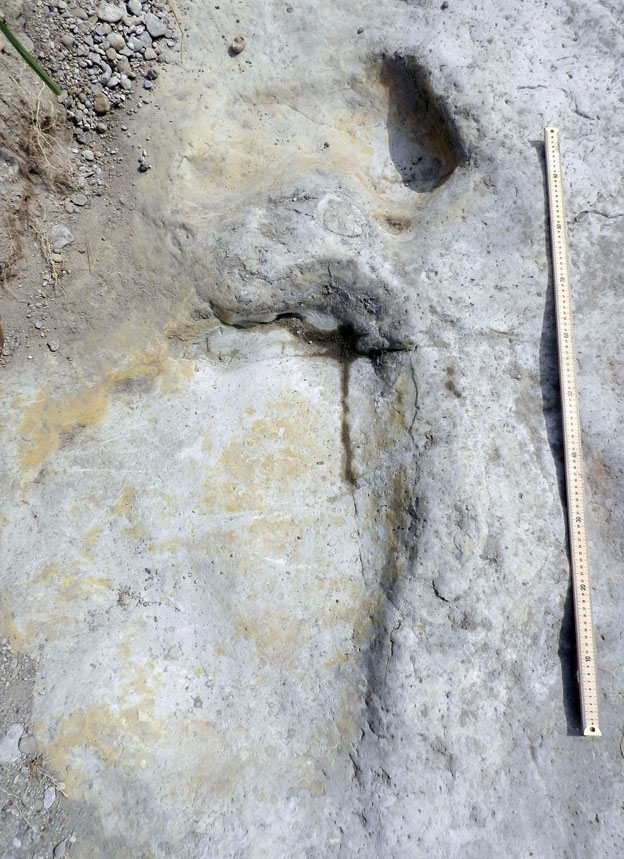 Sauropod tracks from the Early Cretaceous (about 120-million-years-old) Glen Rose Formation of central Texas.The larger track is from the left rear foot, and the smaller one in front of it is the left front foot; this sauropod was walking slowly with an "understep" gait, in which its rear foot stayed behind its front. Please read the preceding text for all of that measurement stuff, which ichnologists sometimes call "data." (Photograph taken by Anthony Martin in Dinosaur Valley State Park, near Glen Rose, Texas.)
Sauropod tracks from the Early Cretaceous (about 120-million-years-old) Glen Rose Formation of central Texas.The larger track is from the left rear foot, and the smaller one in front of it is the left front foot; this sauropod was walking slowly with an "understep" gait, in which its rear foot stayed behind its front. Please read the preceding text for all of that measurement stuff, which ichnologists sometimes call "data." (Photograph taken by Anthony Martin in Dinosaur Valley State Park, near Glen Rose, Texas.)
 To-scale comparison between sauropod track (arrow, lower left) and kaiju track (right) to same scale. Looks like some cute little saurischian would be feeling a little inadequate. As Cowboy Curtis once said on Pee Wee's Playhouse, "You know what they say: Big feet, big boots!" Scale = 10 m.
To-scale comparison between sauropod track (arrow, lower left) and kaiju track (right) to same scale. Looks like some cute little saurischian would be feeling a little inadequate. As Cowboy Curtis once said on Pee Wee's Playhouse, "You know what they say: Big feet, big boots!" Scale = 10 m.
Speaking of high impact, how about track depth and other features of this individual track that might tell us about behavior of the kaiju tracemaker? Oddly enough, the kaiju track looks too shallow to me, measuring only about 1.6 JPU, or about 2.5 m (8 ft) deep. It also lacks pressure-release structures, which are sedimentary structures caused by the tracemaker applying and releasing pressure against the wall of the track. Considering that kaiju were supposed to weigh tens of thousands of tons, this track should have a greater depth, along with major ridges and plates outside of the track outline that would have been imparted by any forward or lateral movement of its foot.
Alternatively, this track may represent more of what I would call a “stamp,” which would have been made by placing a foot directly down onto a soft substrate and pulling it straight up, rather than from moving forward or laterally. Based on this evidence, the kaiju might have been attempting to squish pesky humans, rather thank performing its normal, forward-walking, city-destroying gait. Unfortunately, the preceding and next track are not shown in the photo, which would help to test this hypothesis.
Other than size, how does the form of this track compare to those of other known dinosaur tracks? The length: width ratio comes out close to that of a sauropod dinosaur, yet other qualitative traits of the track, such as thin digits that taper and end with sharp clawmarks, are more like that of a theropod. But I do want to point out a little coincidence. Have you ever seen the front-foot track of a typical raccoon? Hmmm...
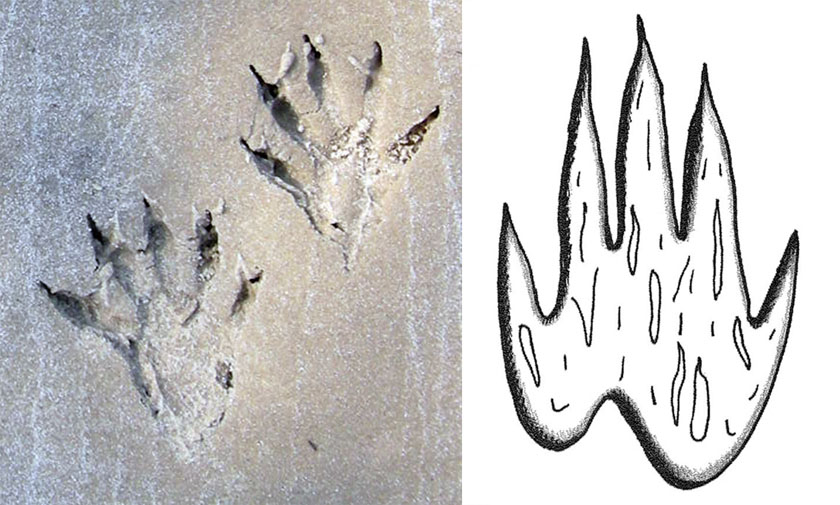 I give you you raccoon tracks, and I give you kaiju track. That is all. (Photo of raccoon tracks taken by Anthony Martin on Cumberland Island, Georgia.)
I give you you raccoon tracks, and I give you kaiju track. That is all. (Photo of raccoon tracks taken by Anthony Martin on Cumberland Island, Georgia.)
What’s really fun, though, is if you compare the kaiju track to known theropod tracks. Theropod tracks bearing four or more forward-pointing toes are quite rare, and the few identified probably belong to a group of theropods called therizinosaurs, which - by a strictly enforced paleo-nerd law - cannot be mentioned in a sentence without also using the descriptor "bizarre." Late Cretaceous dinosaur tracks recently reported from Alaska with four long, forward-pointing digits have been attributed to therizinosaurs. Were the creators of the kaiju track trying to compare it to that of a really strange theropod dinosaur? Maybe, maybe not.
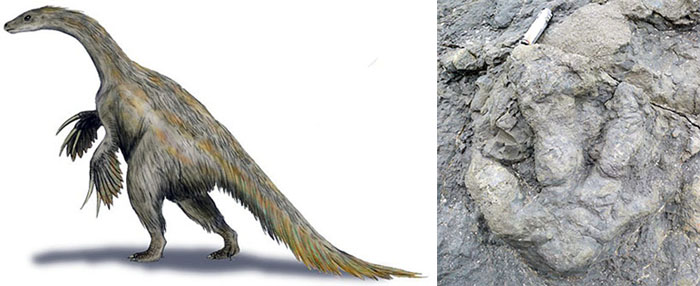 Artistic rendition of Nothronychus mckinleyi, a therizinosaur from the mid-Cretaceous of North America (left) and a four-toed rear-foot track credited to a therizinosaur from Late Cretaceous rocks of Alaska (right). Therizinosaur artwork by paleoartist Nobu Tamara and available in Wikipedia Commons here; photo of track by David Tomeo and reproduced from Everything Dinosaur.
Artistic rendition of Nothronychus mckinleyi, a therizinosaur from the mid-Cretaceous of North America (left) and a four-toed rear-foot track credited to a therizinosaur from Late Cretaceous rocks of Alaska (right). Therizinosaur artwork by paleoartist Nobu Tamara and available in Wikipedia Commons here; photo of track by David Tomeo and reproduced from Everything Dinosaur.
Although the Pacific Rim kaiju designers used a mix of invertebrate and vertebrate elements for anatomical details appearances of their monsters (detailed splendidly by Darren Naish here), I do wonder how they came up with the track, and which real-life animals - modern or extinct - were supposed to be evoked by this track's brief appearance onscreen. Hopefully the DVD and its Special Features will reveal all once that comes out.
(Incidentally, this attempt to divine the evolutionary relatedness of a science-fictional animal from a single track reminds me of a scene from the classic science-fiction film Forbidden Planet. At some point, an invisible monster comes aboard a spaceship on the aforementioned planet and kills its chief engineer. The ship scientist, Dr. Ostrow, then gave a fine interpretation of the monster based on a plaster cast made from one of its footprints, including how it traits seemed to go against all known evolutionary principles. It's such a fun scene, I've shown it in some of my classes as an example of "extraterrestrial ichnology.")
Other tracemaking in the movie, of course, included wholesale destruction of major population centers by the kaiju, clawmarks left on various city substrates, as well as kaiju scat. Unlike other fans of the movie, I've only seen it once so far, and cannot recall whether the following picture of its droppings was flashed on the movie screen or not.
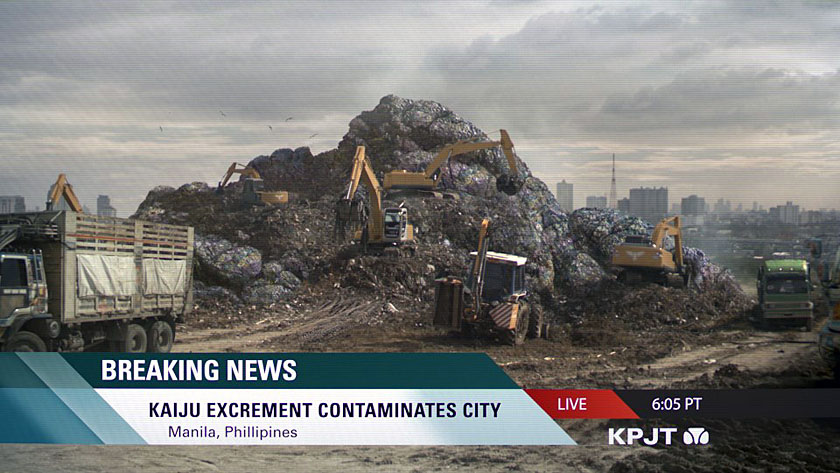 The banner for this news clip says it all: kaiju excrement, and you can bet this much did indeed contaminate a portion of Manila, Philippines (or the "Phillipines," which may be a gated community just outside of Philadelphia.) On the flip side, I'll bet a certain sick Triceratops in the movie Jurassic Park is now a little less self-conscious about having its wastes piled higher and deeper on the big screen.
The banner for this news clip says it all: kaiju excrement, and you can bet this much did indeed contaminate a portion of Manila, Philippines (or the "Phillipines," which may be a gated community just outside of Philadelphia.) On the flip side, I'll bet a certain sick Triceratops in the movie Jurassic Park is now a little less self-conscious about having its wastes piled higher and deeper on the big screen.
One line about their excrement – uttered by kaiju-organ harvester, Hannibal Chau (played by a hilarious Ron Perlman) - alludes to its commercial value based on its phosphorus content. This would accord with the economic importance given to bat or bird guano, which has been mined and sold as fertilizer, and even inspired wars. (I am not making that up.) Still, it would have been beyond awesome to have just one scene showing a deposit of its scat enveloping a large, recognizable monument to a politician in one of those cities.
Hannibal Chau (Ron Perlman), selling kaiju products for whatever might ail you. Alas, their scat is not mentioned in this ad, but he could easily do another one directed at Whole Foods. After all, it would be 100% organic and free-range fertilizer!
What about the jaegers? Their traces are much tougher to discuss, semantically speaking. Ichnologists classify tools themselves as traces of behavior, but most do not count marks made by tools (or machines) as traces. Nonetheless, because the jaegers are being controlled by humans, the marks they leave on the landscape, seascapes, and upside some kaiju’s head, might count as traces, too.
However, in one scene of the movie, in which a kaiju picked up a jaeger and threw it – inflicting much destruction of private and public property – these traces would be those of the kaiju, not the jaeger. I pointed out a similar situation with Jurassic Park. Toward the end of the movie, the poor, misunderstood protagonist of the film - the Tyrannosaurus rex - in an action tinged with self-loathing, hurled a Velociraptor at a mounted T. rex skeleton, no doubt expressing doubt about her place in a post-Mesozoic world. Existentialist angst aside, the destruction of the skeleton was a trace of the tyrannosaur's behavior, not that of the Velociraptor.
So next time you go to a movie featuring multi-ton monsters emerging from the deep sea and massive fighting machines, look for them to make traces, note the traces they make, how these traces may reflect some sort of evolutionary history for the tracemakers, and ask yourself what constitutes a trace. Then no matter how bad the movie, you'll still be guaranteed to enjoy it. Happy movie viewing and tracking!
